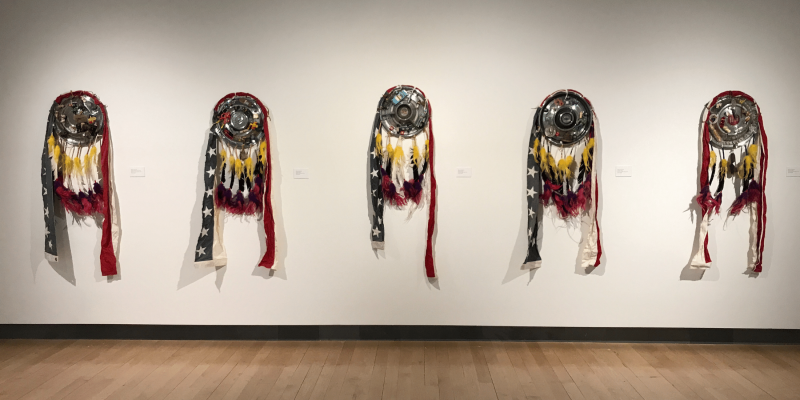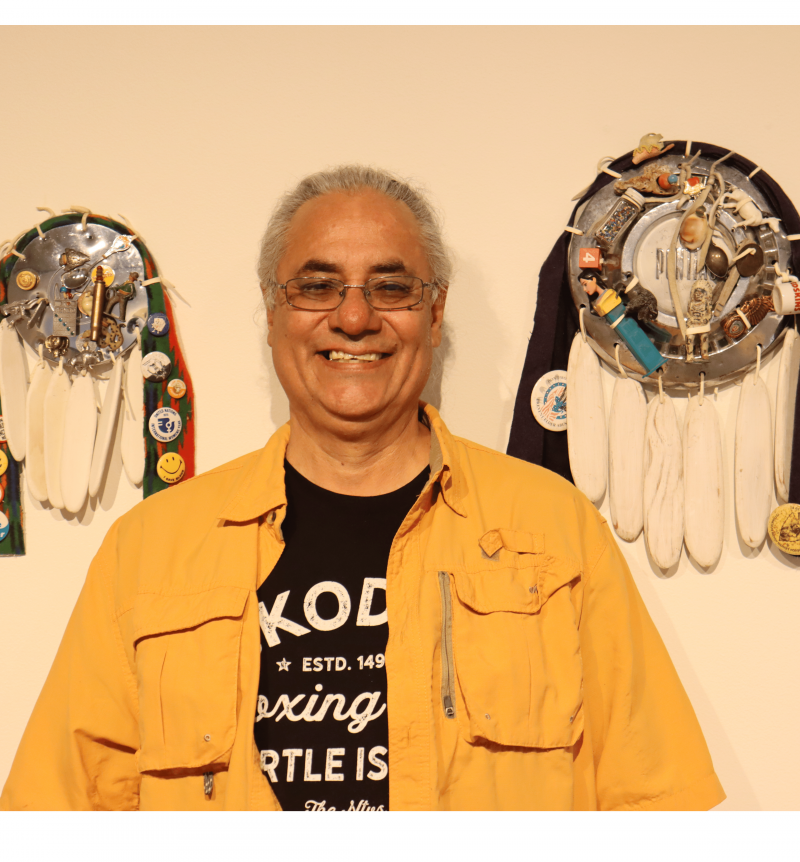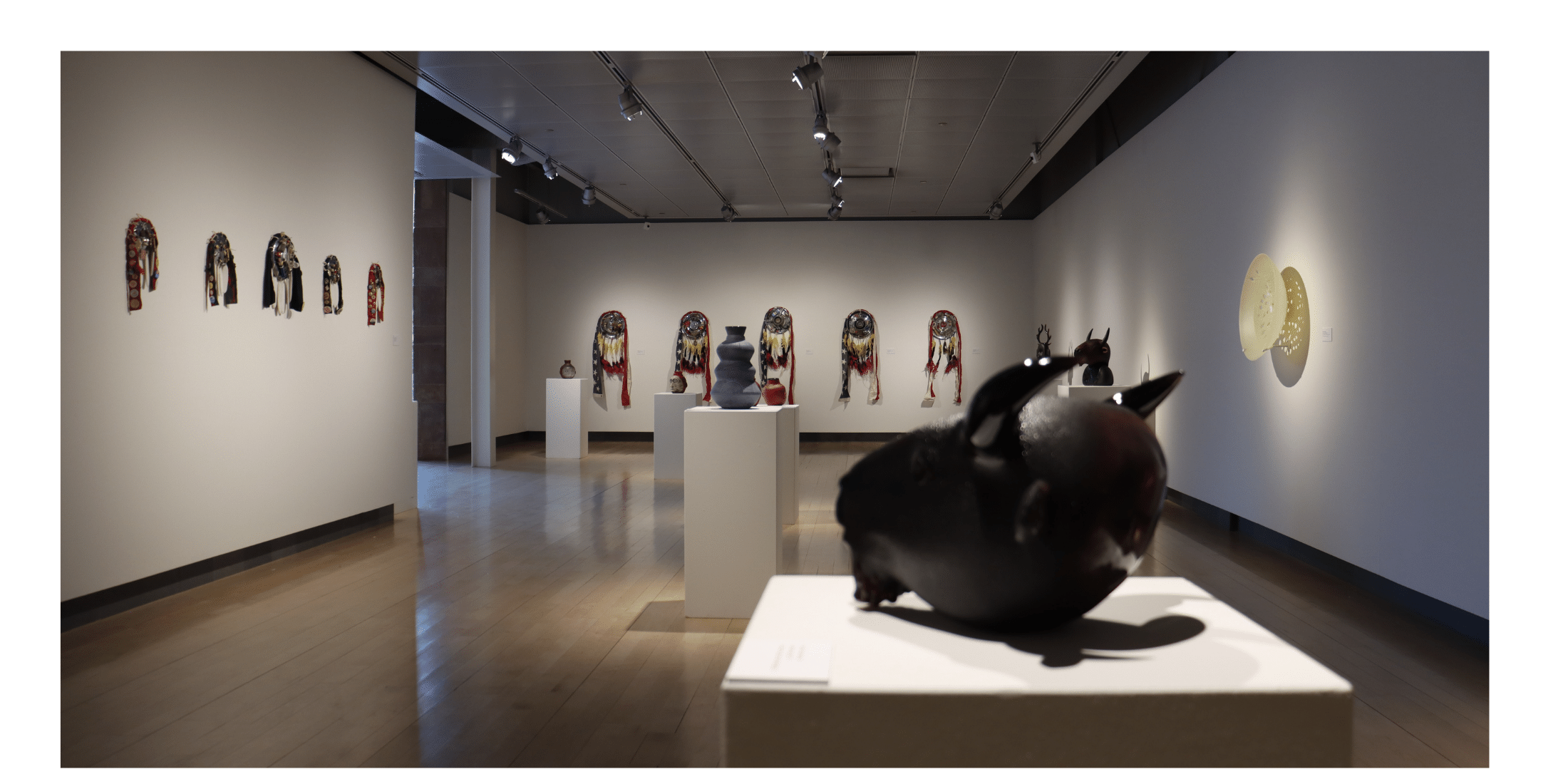Marcus Amerman: Indian Country
March 15 2022 - July 16 2022
This exhibition takes its title from one of Amerman’s (Choctaw) popular "photobeadalist" travel-inspired artworks to declare that the exhibition and, indeed, all of America is Indian Country. Included are sensuous blown- and sand-carved vessels made in collaboration with Tlingit artist Preston Singletary, an assortment of shields made from repurposed hubcaps, and a series of collages made from rock n’ roll backstage passes—all of which reaffirm contemporary Indigenous presence. This exhibition is sponsored by Roemer's Point S Tire & Auto and SG Long Financial.
Related events
Saturday, April 16 - Saturdays with MAM
Saturday, May 14 - Adult workshop with Salish artist Buck Morigeau
About the exhibition
Marcus Amerman is a multi-faceted artist who creates personal expressions across diverse mediums and techniques. He is a painter, beadwork artist, sculptor, and performance artist. Though Amerman may be better known for his beadwork portraits and representational landscapes, this exhibition focuses on contemporary blown glass and mixed media interpretations of traditional objects from his Choctaw heritage.
The exhibition features a diverse range of blown glass works including vessels and sculptures. Approximately half of the glass pieces were made in collaboration with master glass artist Preston Singletary (Tlingit). Amerman reinterprets vessels and effigies made by the pre-Columbian Choctaw people of the Mississippi River valley. His transformation of the original clay vessels and objects into glass radiates with intensity. The range of style and expressions that glass offers is on display from the sculptural vessels, the large plates with etched-line design, to the purely sculptural, stylized bison heads and figures. Other glass vessels like Keno-Trailed Water Vessel honor the forms and scrolling line of the traditional pottery that was considered the apogee of technical and aesthetic mastery. The Deer Man of Cahokia refers to the mound settlement known as Cahokia in Illinois. At its peak, Cahokia was the largest settlement in North America, rivaling many global cities for size and organization.
In contrast to the smooth surfaces and hard lines of the glass works are a series of war shields created from found and gathered materials, carefully arranged. Shields are meant to protect, defend, and express identity. Amerman’s shields have replaced rawhide with a hub cap as the central component. One of them proclaims Pontiac, embossed in the chrome metal. All are adorned with long strips of shredded flags and feathers and decorated with small objects, meant as protections, that offer viewers places to explore. Amerman presents these as a series of portraits, which is significant. Amerman’s mixed-media approach extends to My Neural Scroll, a series of collages made with backstage passes from Rock and Metal concerts, which showcase the artist’s creative process and afford an insight into how he develops and pursues ideas.
Amerman restlessly creates in numerous media and inventively explores artistic forms to create insightful social and cultural commentary. He simultaneously upholds thousands of years of creative, artistic expression, while declaring that Indigenous people are still here, still creating, still part of the conversation, and in fact, we are all living in Indian Country.


About the artist
Marcus Amerman (Choctaw) was born in Phoenix, Arizona, and grew up in the Pacific Northwest. He divides his time between Kooskia, Idaho, and Santa Fe, New Mexico. He received a BA in Fine Art at Whitman College in Walla Walla, Washington, with additional art study at the Institute of American Indian Arts in Santa Fe.
Amerman is widely renowned for his beadwork. He credits the Plateau region and its wealth of talented bead artists with introducing him to the “traditional” art form of beadwork. He quickly made this art form his own, however, by creating a new genre of bead artistry in which beads are stitched down, one by one, to create realistic, pictorial images, not just large color fields or patterns.
Amerman draws upon a wide range of influences to create strikingly original works that reflect his background of having lived in three different regions with strong artistic traditions, his academic introduction to pop art and social commentary, and his inventive exploration of the potential artistic forms and expressions using beads. Although he is best known for his bead art, he is also a multimedia artist, painter, performance artist (his character “Buffalo Man” can be seen on the cover of the book Indian Country), fashion designer, and glass artist, as well.


